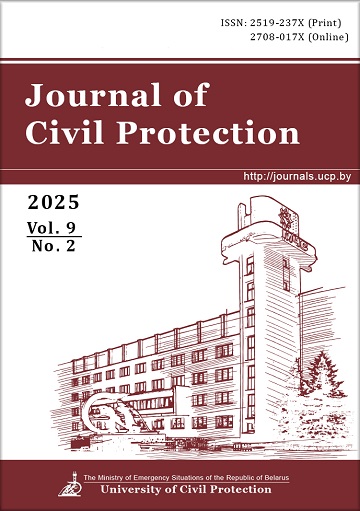Engineering method for determining fire safety spacing between buildings with gable roofs made of combustible materials
DOI:
https://doi.org/10.33408/2519-237X.2025.9-2.139Keywords:
fire safety spacing, geometric parameters of flame, configuration factor, experimental studies, modelingAbstract
Purpose. To develop a scientifically grounded engineering method for determining fire separation distances between residential buildings with gable roofs made of combustible materials, taking into account the shape of roof and geometric parameters of the radiating surface.
Methods. Analysis of experimental data on the area of the radiating surface, temperature fields at distances ranging from 0.5 to 1.5 m both vertically and horizontally from an experimental fragment of a gable roof, as well as heat flux density. Numerical simulation of heat and mass transfer and radiative heat exchange processes using the ANSYS Fluent computational fluid dynamics solver.
Findings. It was found that during the combustion of the gable end, a triangular radiating surface is formed, which fundamentally differs from the existing calculation model based on rectangular radiating surfaces. Experimental dependencies were obtained for the variation of temperature, heat flux density, and radiating surface area over the duration of the fire. A numerical calculation model was developed, enabling the acquisition of new data without full-scale fire tests. Analytical relationships were established between the geometric parameters of the roof and the height of the radiating surface.
Application field of research. Determination of the size of fire safety spacing between buildings with gable roofs made of combustible materials. Design of low-rise residential buildings, in terms of assessing fire safety spacing between buildings and structures, as well as the development and updating of technical regulatory legal acts in the field of fire safety. The results of the study are of practical interest to engineering organisations, design institutes, workers of the Ministry for Emergency Situations, and scientific and educational institutions.
References
Pastukhov S.M., Zhamoydik S.M., Teteryukov A.V. Analiz podkhodov po otsenke minimal'no dopustimykh rasstoyaniy mezhdu zdaniyami pri vozdeystvii pozhara [Analysis approaches for the assessment minimum distance between the buildings at the case of fire exposure]. Vestnik Komandno-inzhenernogo instituta MChS Respubliki Belarus', 2014. No. 2 (20). Pp. 23–31. (rus). EDN: https://elibrary.ru/SWENLV.
Сох G. Combustion fundamentals of fire. London: Academic Press, 1995. 476 p.
Puzach S.V. Metody rascheta teplomassoobmena pri pozhare v pomeshchenii i ikh primenenie pri reshenii prakticheskikh zadach pozharovzryvobezopasnosti [Methods for calculating heat and mass transfer during indoor fires and their application to practical fire and explosion safety tasks]. Moscow: Academy of State Fire Service of EMERCOM of Russia, 2005. 150 p. (rus)
Roytman M.Y. Protivopozharnoe normirovanie v stroitel'stve [Fire safety regulation in construction]. Moscow: Stroyizdat, 1985. 590 p. (rus)
Grushevskiy B.V., Yakovlev A.I., Krivosheev I.N., Shurin E.T., Klimushin N.G. Pozharnaya profilaktika v stroitel'stve [Fire prevention in construction]: textbook. Ed. by V.F. Kudalenkin. Moscow, 1985. 454 p. (rus)
Chitty R. External fire spread: building separation and boundary distances. 2nd ed. Garston, Watford: Building Research Establishment, 2014. 68 p. ISBN 9781848063198.
Drysdale D. An Introduction to Fire Dynamics. Chichester: University of Edinburgh, 1999. 470 p.
Karlsson B., Quintiere J.G. Enclosure Fire Dynamics. Boca Raton: CRC Press, 2000. 316 p.
Carlsson E. External fire spread to adjoining buildings – A review of fire safety design guidance and related research. Lund: Department of Fire Safety Engineering Lund University, 1999. 125 p.
Law M. Heat radiation from fires and building separation distance. Fire Research Technical Paper No. 5. London: Her Majesty’s Stationery Office, 1963. 45 p.
Pesic D., Zigar D., Raos M., Anghel I. Simulation of fire spread between residential buildings regarding safe separation distance. Technical Gazette, 2017. Vol. 24, No. 4. Pp. 1137–1145. DOI: https://doi.org/10.17559/TV-20150923233514.
Edalati-Nejad A., Ghodrat M., Fanaee S.A., Simeoni A. Numerical Simulation of the Effect of Fire Intensity on Wind Driven Surface Fire and Its Impact on an Idealized Building. Fire, 2022. Vol. 5, No. 1. Article 17. 18 p. DOI: https://doi.org/10.3390/fire5010017.
Pastukhov S.M., Teteryukov A.V. Metodika provedeniya eksperimental'nykh issledovaniy po opredeleniyu geometricheskikh parametrov plameni pri gorenii krovel'nykh materialov [The method of experimental researches to determine the geometric parameters of the flame during combustion of roofing materials]. Journal of Civil Protection, 2018. Vol. 2, No. 2. Pp. 176–185. (rus). DOI: https://doi.org/10.33408/2519-237X.2018.2-2.176. EDN: https://elibrary.ru/XPAXID.
Pastukhov S.M., Platonov A.S., Teteryukov A.V., Drobysh A.S. Matematicheskaya model' opredeleniya uglovogo koeffitsiyenta obluchennosti pri raschete protivopozharnykh razryvov mezhdu zdaniyami s dvuskatnymi krovlyami, vypolnennymi iz goryuchikh materialov [Mathematical model for determining the configuration factor when calculating fire risks between buildings with double roofs made of combustible materials]. Journal of Civil Protection, 2021. Vol. 1, No. 1. Pp. 93–103. (rus). DOI: https://doi.org/10.33408/2519-237X.2021.5-1.93. EDN: https://elibrary.ru/DBRUSN.
Pastukhov S.M., Platonov A.S., Teteryukov A.V., Drobysh A.S. Matematicheskaya model' opredeleniya uglovogo koeffitsienta obluchennosti dlya rascheta plotnosti teplovogo potoka ot izluchatelya ploskoy formy [Mathematical model for determining the angular irradition coefficient for calculating the heat flux density coming from a plane-shaped emitter]. Journal of Civil Protection, 2025. Vol. 9, No. 1. Pp. 5–20. (rus). DOI: https://doi.org/10.33408/2519-237X.2024.9-1.5. EDN: https://elibrary.ru/DIVTKW.
Snegirev A.Yu., Talalov V.A. Teoreticheskie osnovy pozharo- i vzryvobezopasnosti [Theoretical foundations of fire and explosion safety]. St. Petersburg Polytechnic University, 2007. 215 p. (rus)
Wilcox D.C. Turbulence modeling for CFD. La Canada, California: DCW Industries Inc, 1998. 537 p.
Menter F.R. Two-equation eddy-viscosity turbulence models for engineering applications. AIAA Journal, 1994. Vol. 32, No. 8. Pp. 1598–1605. DOI: https://doi.org/10.2514/3.12149.
Hankalin V., Ahonen T., Raiko R. On thermal properties of a pyrolysing wood particle. Proc. of Finnish-Swedish Flame Days 2009, January 28-29, 2009, Naantali, Finland. 16 p.
Published
How to Cite
License
Copyright (c) 2025 Pastukhov S.M., Chorny A.D., Teteryukov A.V.

This work is licensed under a Creative Commons Attribution-NonCommercial 4.0 International License.




















